February 2003 (Part 2)
SELECTION OF QUESTIONS AND ANSWERS
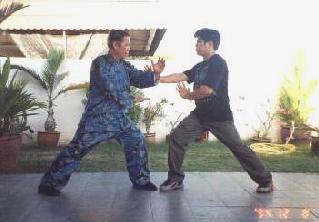
Sifu Wong and his son, Wong Chun Nga, enact a sparring session Sifu Wong had with a Wing Choon master about 25 years ago.
Question 1
According to your statements, Bak Mei was a Buddhist priest. So I assume that those shows which show him as a long haired long robed Taoist priest are wrong. Am I right? I assume that his real look would be an orange robe with a bald head. And if Li Pa San (real life person?) and Bak Mei were really from Wudang, how come both could kick powerfully and Bak Mei had “cotton belly skill”? Shouldn't they both be using something soft like Tai Chi?
— Vincent, Malaysia
Answer
You have misquoted me. Bak Mei was a Taoist priest, and not a Buddhist monk. Those movie shows were right. Bak Mei had long white hair tied in a Taoist bun, and he wore a long grey Taoist robe.
Li Pa San, whom I believed was a real life person, was the most senior disciple of Bak Mei. Li Pa San was the first patriarch of Li Ka Kungfu (Li Family Kungfu). He was very good with his phoenix-eye fist and organ-seeking kick, which were two of the specialties of Bak Mei.
What Bak Mei and his disciple Li Pa San practiced was also Southern Shaolin Kungfu. Bak Mei was the siheng, or senior classmate, of Chee Seen. Both of them learned from Jeong Mei Cheong Lou, the abbot at the Quan Zhou Shaolin Temple in Fujian Province of South China. Chee Seen succeeded Jeong Mei as abbot, while Bak Mei retreated to the Ermei Mountain in Szechuan Province to continue his cultivation.
Shaolin Kungfu has a very externsive repertoire. While the fundamental skills and techniques of Bak Mei and Chee Seen were the same, their specialization was different. Chee Seen specialized in Iron Head, Tiger-Claw and No-Shadow Kicks, and his favourite style was the Lohan.
Bak Mei was a kungfu genius. He had many specialties, and was best known for his “tongzigong” or the “Art of Being Childlike”, enabling him to be youthful even at old age, despite his white hair and long white bead. He was also expert in “mianhuagong” or “Cotton Art”, which included “Cotton Palm” and “Cotton Belly”. His favorite style was the Dragon, and he was extremely skilful at the phoenix-eye fist, striking the opponent's vital points.
As he stayed at the Ermei Mountains (Mountains of Swan's Eyebrow), Bak Mei's kungfu was known as Ermei Shaolin Kungfu, to differentiate it from the Fujian Shaolin Kungfu of Chee Seen, but later was shortened to Ermei Kungfu. Today Ermei Shaolin Kungfu has evolved into Bak Mei Kungfu, named after him, and Dragon Style Kungfu, name after his favourite style.
Bak Mei's kungfu was not Wudang Kungfu or Taijiquan. Of course, Bak Mei as well as Li Pa San or any kungfu master of any style including Taijiquan, could kick powerfully. “Cotton belly skill”, which was one of Bak Mei's many specialties, was a Shaolin art, but it was not popularly known. “Cotton Art” is even “softer” than Taijiquan. My Wuzu Kungfu master, Sifu Chee Kim Thong, knew “Coton Art”, but I did not have the opportunity to learn it from him.
You may have confused Bak Mei's kungfu with Foong Tou Tak's kungfu. Like Bak Mei, Foong Tou Tak was a Taoist priest, and he was a junior classmate of Bak Mei and Chee Seen. He retreated to the Wudang Mountain in Hubei Province for cultvation. What he practiced was Shaolin Kungfu, not Taijiquan, and as he stayed at Wudang Mountains his style of Shaolin Kungfu was known as Wudang Shaolin Kungfu. Gradually it was just called Wudang Kungfu.
Foong Tou Tak's Wudang Kungfu was not the same as Zhang San Feng's Wudang Kungfu, which later developed into Taijiquan. Yet, these two styles of Wudang Kungfu were similar in some ways. Both were developed from Shaolin Kungfu. Like Zhang San Feng, who lived many centuries before him, Foong Tou Tak's speciality was also chi cultivation. But Zhang San Feng's movements resembled more of the snake and the crane, whereas Foong Tou Tak used the phoenix-eye fist to strike the opponent's vital points, and his style was comparatively hard like that of Shaolin.
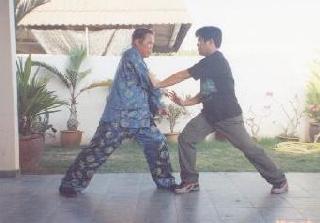
Wong Choon Nga “tames” Sifu Wong's arms with his left hand. Notice that in this position, Sifu Wong could not use either of his two hands for attack or defence.
Question 2
Someone has said that Hung Ga is just like Karate, as it is all just "muscles". What do you think?
Answer
Your question is an example of dualistic thinking, which is characterized by a presumption that the answer can only be either yes or no, either black or white. To obtain full benefit from the answer, first of all we have to do away with dualistic thinking, and accept that there can be many different answers and all of them, even though some of them may be completely opposite to one another, can be correct, or all of them can be wrong in different situations.
My thinking, which is non-dualistic, is as follows. Hoong Ka Kungfu (Hung Gar) is very different from Karate. It is not all “muscles”. In fact there is a lot of internal work in Hoong Ka Kungfu. Hoong Ka Kungfu places great importance on “chiat ma” or stance training, and stance training is no muscle work, it is a training of energy and mind.
The two most famous kungfu skills of Hoong Ka are tiger-claw and no-shadow kicks, and they avoid muscle work. Tiger-claw depends on internal force, and no-shadow kicks on tactics and speed. The advanced Hoong Ka kungfu set, “Iron Wire”, does not use muscles; it uses mind and energy to develop “jin”. or internal force, although interestingly some Koong Ka exponents develop muscles by practicing this set.
It is illuminating that from their photographs it is clear that two of the most famous Hoong Ka masters of recent times, Wong Fei Hoong and Lam Seai Weng, did not have big muscles. They had a small “drum” at their belly, which indicated the source of their tremendous internal force, but which muscle-loving persons like body builders would not like to possess.
On the other hand, there may be some truth in believing that Hoong Ka is all muscles like Karate! This is because there are many modern Hoong Ka practitioners, including some masters, who are muscular. They also incorporate body-building and weight-lifting into their kungfu training.
As I have often mentioned, different schools and different masters have different methods and approaches. The Hoong Ka Kungfu that I learned from Uncle Righteousness and also from Sifu Ho Fatt Nam, did not involve muscle work like body-building and weight-lifting, though we sometimes used weights as a supplements, and accordingly the Hoong Ka Kungfu that I teach to my students now focuses more on chi cultivation.
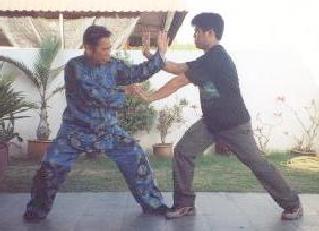
Wong Chun Nga attacks Sifu Wong with his right hand. Sifu Wong sits back on his stance to release his hands from Wong Chun Nga's “taming hand”, and wards of the attack with his left hand.
Question 3
It is also said that a Hung Ga expert can be beaten by a Wing Chun exponent using the Wing Chun centre line theory. What is your opinion?
Answer
Yes, a Hoong Ka expert can be beaten by a Wing Choon exponent, and similarly a Wing Choon expert can be beaten by a Hoong Ka exponent. Victory in combat depends on numerous factors.
Indeed, those who have been involved in real fights even for a few times, will tell you that techniques (from Hoong Ka Kungfu, Wing Choon Kungfu, or any other martial arts) constitute only one factor in combat, and often it is the least crucial factor. More important are your presence of mind, your force and your prior fighting experience. Superficially, this is one reason why most kungfu practitioners, including instructors, do not or cannot use their kungfu techniques in combat, even in sparring amongst their classmates.
This does not mean that practicing kungfu techniques is useless. Kungfu techniques are excellent for combat, otherwise they would not be passed down in kungfu forms. Then, why do many kungfu practitioners resort to freestyle or children's fighting when they could perform beautiful kungfu forms in solo training?
The answer is straight-forward: they have not been trained to do so. Saying that they learn kungfu forms to get the “spirit” with which they would apply in their freestyle sparring, if they ever spar, is a blatant refusal to admit this lack of kungfu combat training.
In kungfu combat training, we do not just practice or apply techniques in isolation. In other words, when we use kungfu techniques in sparring practice, we also enhance our presence of mind, apply force, improve fighting experience as well as other factors all at the same time.
Can we do the same things using freestyle sparring instead? We can, but using kungfu techniques is far more superior. It represents centuries of development by kungfu masters in the past from their actual fighting experience.
The centre line theory is not exclusive to Wing Choon Kungfu; it is also used in other martial arts, including Hoong Ka Kungfu. Moreover, this centre line theory is a guide, and can be applied in numerous ways. It does not necessarily mean that all Wing Choon attacks and counter-attacks must follow the centre line, as some people may think.
For example, when a Hoong Ka exponent gives me a typical thrust punch, “Black Tiger Steals Heart”, instead of responding with a typical Hoong Ka defence followed by a typical Hoong Ka counter-attack, namely “Single Tiger Emerges from Cave” followed by “Black Tiger Steals Heart”, I can respond with a typical Wing Choon counter-attack, “Tan Sau Phew Chee”, warding off his punch with my left mirrow hand and striking his throat with my right finger-thrust at the same time.
This Wing Choon counter-attack makes use of the centre line theory, and is probably what some people have in mind when they think of using this theory to beat a Hoong Ka exponent. In the Hoong Ka response described above, there are two movements — defending with a tiger-claw, then counter-attacking with a thrust punch; whereas in the Wing Choon response there is only one movement, defending and counter-attacking at the same time, striking the opponent even before he can pull back his initial attack.
I can also use this centre line theory in another way. As his right thrust punch is approaching, I move diagonally to my left side and strike a pheonix-eye fist at his right ribs using a Wing Choon pattern called “Chak Sun Foong Ngian”. This pattern, I believe, may not be found in Yip Mann Wing Choon, the most popular version of Wing Choon practiced today, but is found in the version of Wing Choon I practice, Choe Family Wing Choon. Here I purposely move away from the centre line, thus avoiding the opponent's attack, and counter-attack from the side, hitting the opponent at about the same time when his initial attack is just spent. It applies the famous Wing Choon principles of economy of movements and speed.
In the above examples, it is presumed that the Hoong Ka exponent is too slow or does not know how to respond correctly. If he is skilful, there are many Hoong Ka counters against these two Wing Choon attacks. Indeed, these two Wing Choon patterns are also found in Hoong Ka, known respectively as “Beauty Looks at Mirrow” followed by “Poisonous Snake Shoots Venom”, and “Shooting Arrow Below Sleeves”.
If you wish to be a good fighter in a short time, and if all other things were equal, which is almost never valid in real life, practicing Wing Choon is a better choice than practicing Hoong Ka. But if you wish to have other benefits besides fighting ability, I would suggest Hoong Ka. Even if you consider only combat efficiency, if you are prepared to train for a longer period, Hoong Ka would give you an edge. The following real life story would explain why.
Many years ago when I was learning Wing Choon Kungfu from Sifu Choe Hoong Choy, I had an opportunity to spar with a Wing Choon master. His “chi sau” (Sticking Hands) was excellent, “covering” my both hands so well that it was difficult for me to attack or defend. But, knowing that I had much sparring experience, he wanted to make doubly sure he would defeat me in this friendly sparring session. After covering my hands so well, he could have attacked me, but he didn't. He made a feign move which I attempted to defend, then he disappeared from sight!
His footwork was also so good that he got behind me without my knowing. But I sensed an attack on the back of my head. (Of course he did not really hit me, he just wanted to touch the back of my head to register a strike.) Spontaneously I dropped onto the ground on my back and kicked up, using a Shaolin pattern called “Reversed Kicking at Purple Bell”. Looking up from below I could see his surprise. At the time he thought he could touch the back of my head, he found my toes just an inch from his throat!
He was pleased with the friendly sparring. Smilingly he complained, “But this is not Wing Choon Kungfu!” I was a bit embarrassed. Although in ranking we were equal, in age he was much my senior. I was also surprised at the excellent counter! I did not plan it, it just flowed spontaneously.
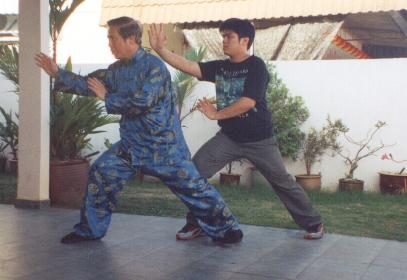
Chun Nga's attack, however, is a feint. As Sifu Wong responds to this feint attack, Chun Nga has moved to the back of Sifu Wong. Sifu Wong turns to look for his opponent but could not find him.
Question 4
Sifu, Liipster asks in response to your answer to his earlier question why he has never heard of or seen any other Shaolin school that replaces so much of the external training that he does, with internal cultivation. He wrote “My question was that I had not seen any other genuine or traditional Shaolin Kung Fu schools that advocated so much chi cultivation and not such a stress on external?” Please could you explain further?
— Dan, United Kingdom
Answer
There are three likely reasons why Lipster has never heard of or seen so much internal cultivation like what we practice in our Shaolin Wahnam School.
One, what we do at Shaolin Wahnam is rare. Two, what we teach at the early stage of our students' training, like internal force and combat application, was and still is usually taught in a much later stage in most other schools, if these schools ever taught such material at all. Three, Lipster's concepts of kungfu, wushu, force training and other related topics are very different from ours.
Very, very few schools in the world today train the way we do. We have no problem with that. We recognize and respect the right and wish of other people to train the ways they think best. We never go round thrusting our views on others, or running them down, as Lipster explicitly said in a public discussion forum. (“Look, one thing I would like to understand about WKK. I think it is one of the reasons Arhat got so aggressive. Why does WKK run things down so much?”)
But when others ask us for advice, we give it honestly and generously — advice that many people appreciate and thank me for, some saying it has helped them to solve problems which have troubled them for years, and some expressing surprise that I have been so open with “secrets”. If Lipster and some others do not like our advice (which they themselves asked for in the first place) they can throw it away as rubbish.
One example of how we try to help is the picture of children performing wushu shown in my January 2003 Part 1 series. Enduring pains at their knees, shoulders and back is a common problem with many students and instructors of wushu and various martial arts.
The picture and accompanying explanation could help some to define the cause of their problem, then overcome it. Telling them through the picture and explanation that performing their wushu or martal art movements with their knees or shoulders blocked may cause pain and injury, is not running them down, it is helping them if they appreciate the advice.
We sincerely believe that what we practice now, was what Shaolin disciples did in the past. We have ample evidence ourselves for our own conviction. For example, we believe that Shaolin disciples in the past practiced chi kung exercises like “Golden Bridge” and Sinew Metamorphosis”, applied the same skills and techniques they ardently practiced for combat as well as in their daily life, and believed in and actually experienced spiritual development. We practice what we believe, and are very happy with our results.
We would also add that what the Shaolin monks practiced in the past was also rare at their times. Even the chance of practicing kungfu itself was rare anywhere in China. Much of what most kungfu practitioners trained was external, like hitting sandbags, striking poles, lifting stone-locks and going over a lot of forms. Practicing chi kung and Zen, like what the traditional Shaolin monks did, was an extremely rare opportunity.
If others believe that hard conditioning and weight-lifting are better for force training, prefer using skills and techniques similar to those in Western Boxing or Kickboxing in combat, and that wushu and martial arts are purely physical and that there is no room for mind or soul in their training, that is their choice, and we have neither right nor desire to change them.
From their discussion it appears that Lipster and a few others think we try to covert them. It is not so. If they are happy with their teachers, continue training with them. In fact, I have often mentioned in the question-answer series that those who wish to attend my intensive courses, if they are qualified to do so, should use my teaching as supplement to their regular training, and that even if they have surpassed their teachers, they must continue to respect and honour them.
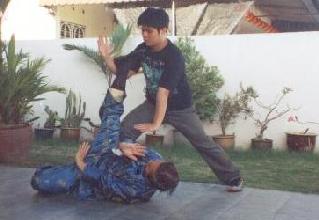
Nevertheless, Sifu Wong senses an attack on the back of his head. Instantly he drops to the ground and kicks up and backward with his toes at the opponent's throat, using a Shaolin pattern known as “Reversed Kicking of Purple Bell”.
Question 5
Sifu, in further discussion about how our training is relatively internal compared to the modern Shaolin monks' training which is relatively external, Bhodi wrote; “The heart of the question presented by Lipster, as I see it, is why are WKK's methods of training so different?” Please could you clarify what you consider internal and external training and explain the differences between them?
Answer
Different teachers teach, or train, differently, and the same teacher teaches differently in different situations or for different purposes. Your teaching, Dan, is different from mine, and my teaching is different from my sifus'.
Also, the way I teach now is vastly different from the way I taught twenty years ago. And what I teach in my regional classes is different from what I teach in my intensive courses, although the content may be the same.
Logically what we teach in Shaolin Wahnam is different from what modern Shaolin monks teach today, or what traditional Shaolin monks taught three hundred years ago, although all of us are (were) teaching Shaolin Kungfu.
It is too long and complicated to explain the reasons for all these differences. But the reasons can be summed up by saying that the variables are different — different personalities, philosophy, training, experience, time, environment, culture, students, resources, needs and aspirations.
But this is probably not what Bhodi and Lipster look for in my answer, though the above explanation provides the conceptual framework for the differences.
I reckon that Bhodi and Lipster refer to Shaolin Kungfu, and compare my methods of training (or teaching) with those of his teachers or other teachers in general, especially in relation to internal and external training.
The main causes for the differences, I believe, are due to different philosophy, experience and aspiration.
Philosophically, I believe that Shaolin Kungfu is a comprehensive programme for physical, emotional, mental and spiritual development. I stress that we are serious about our philosophy. It defines both our vision and our direction of training.
Speaking quantitatively, which may not be accurate but which gives some basis for comparison, three out of four goals in our vision concern internal dimensions. It is no surprise, therefore, that much of our training is internal.
Without being disrespectful, I believe many teachers are not consciously aware of their philosophy or of their and their students' aspirations. The underlying philosophy of their training, often unconscious to them, is often determined by their history and environment. Hence, they teach according to the way they have been taught, often without clear-cut vision and direction. Sometimes they may make changes, but these are usually to meet ad hoc expediencies.
Their history and environment are such that external training is emphasized. Many kungfu masters (the real ones who can use their kungfu techniques for combat) came from a tradition of revolutionary fighters who preferred fast, visible results from external training like punching sandbags and striking poles.
Later, many others came from the modernized wushu tradition where the emphasis was on beautiful external forms for demonstration. The environmental influence of karate and later kickboxing, especially in free sparring, further shaped their preference for external training.
Not many teachers, therefiore, have experience of internal training themselves. Consequently their teaching is mainly external.
Understanding what is internal and external training is very useful, and will help to clear much confusion. An important kungfu principle says, in Cantonese, “noi lien jing shen hei; ngoi lien ken kuet pei.” In Mandarin it sounds as follows, “nei lian jing shen qi, wei lian jin gu pi.” It means internal training involves cultivating essence, mind and energy; external training involves cultivating muscles, bones and skin.
An example of cultivating essence is “Golden Bridge” where energy is “consolidated” into “essence” or internal force. An example of cultivating mind is Standing Meditation, where we attain mental clarity and freshness. An example of cultivating energy is “Abdominal Breathing” where energy is accumulated at the abdominal dan tian, or energy field.
An example of cultivating muscles is stretching exercise, where we attain speed and agility. An example of cultivating bones is striking our arms against a pole to harden and condition them. An example of cultivating skin is hitting ourselves with a bundle of sticks to condition our body to withstand punches and kicks.
There are two points worthy of note. The classification into internal and external training, and into essence, mind and energy, and into muscles, bones and skin are arbitrary and for the convenience of understanding. In reality there is a lot of overlapping.
Secondly, I am talking about internal and external force training, which is “lien kung” in Cantonese, or “lian gong” in Mandarin. If you repeatedly perform kungfu sets, or one kungfu set many times, without any clear vision and direction of force training, or of training of any skills, it is not “lien kung” or force training. From our perspective, it is not even “lien kuen” or “technique training” — it is a waste of time, an example of what we call “water-buffalo” method.
The “water-buffalo” (meant here as an endearing term, not as an insult — one of my sihengs, or senior classmates, who had helped me very much, was a very powerful “water-buffalo”) thinks that he may increase his speed and stamina. Any increase is incidental, not methodical, and therefore not much. Fast performance without proper methods will result in poor breath control, as well as faulty forms. More seriously it may overburden and weaken his internal organs.
But, if he first performs the patterns in the set slowly to achieve perfect form, that is “lien kuen” or technique training. Then, by using appropriate breathing methods he links the patterns into smooth sequences and performs them with force and speed, without sacrificing correct form and without being short of breath, that is “lien kung” or force training. He would transform himself from a “water-buffalo” into a smart practitioner.
Is this process of transforming a “water-buffalo” into a smart kungfu exponent internal or external training? Here is a good example of the overlapping of internal and external. It is also a good example of the confusion Bhodi and Lipster may be caught in (at the risk of they calling me running them down, though it is a sincere attempt to help them).
The actual performance of the kungfu set is external training. The various modes of breath control and mind focus for different purposes in the performance of the set are internal training. For example, at the start when you perform the Shaolin salutation pattern, the form is external, whereas focusing chi at the dan tian and letting the mind to be peaceful and expanding are internal.
In performing a sequence of patterns, attaining fluid and fast movements is external training. Letting your chi flow to accomplish fluidity and speed, regulating your breathing so that you can complete the sequence without being out of breath, and using your mind to explode out internal force in a decisive strike at the end of the sequence, are internal training. Hence, internal and external training are integrated. But uninitiated persons observing the performance would miss the internal training, they may not even realize the external training, they merely see a performance of external forms.

Sifu Wong demonstrating Golden Bridge, an art excellent for cultivating jing
Question 6
If a person chooses not to abstain from regular sex and his objective is to achieve the 'Small Universe', how long will it take on average, if he practices chi kung 30 minutes daily fairly consistently?
— Ricky, Malaysia
Answer
There are two types of break-through in the Small Universe, namely apparent break-through and real break-through. If you practice the right chi kung exercise correctly, or if a master helps you, you can have an apparent break-through in 5 minutes, even though you had sex the hour before and have sex the hour after.
An apparent break-through is when a bubble of chi goes round the ren and du meridians, or conceptual and governing meridians. Although the effect is short-term, it is refreshing and energizing. However, blockage may soon resume. The “soon” may mean a few minutes, a few hours, a few days or a few weeks later, depending on various factors.
A real break-through is when a whole volume of chi goes round the ren and du meridian, without any interruption or blockage in between. Unless there are very strong factors affecting the small universal chi flow, such as an injury inflicted by a kungfu expert with internal force, or the practitioner has totally neglected his training for a long time yet exposed to severe stress, once the Small Universe is attained, it will continue forever as long as the practitioner maintains the flow with his small universal breathing, which will have become natural to him.
For a real breal-through, if you continue to have regular, wholesome sex, which is encouraged, and practice about 30 minutes a day, regularly and correctly, you should attain the Small Universe in about a year. If you have favorable pre-natal qualities, such as you can enter into a deep state of mind easily and your chi flow is vibrant, you may attain the Small Universe in six months.
The Small Universe is an advanced art. One should attempt it only under the supervision of a master.

Sifu Wong demonstrating Standing Meditation for cultivating shen or mind.
Question 7
I purchased your book “The Art of Shaolin Kung Fu” and have found it very beneficial and enlightening. However, when I practice the stretching exercises in your book or any other stretching exercises recommended to me I experience pains in my hips which I feel are preventing me from achieving the optimum stretch I am capable of. Have you come across this problem before either in training yourself or in teaching others?
— John, USA
Answer
Stretching is an important part of kungfu training, though some schools do not pay much attention to it. It is simple but not easy as it demands much perseverance as the leg muscles become tight again very quickly.
There are four possible reasons for the pains in your hips when practicing stretching exercises. One, you practice wrongly. Two, your practice is correct but you have overdone it. Three, your practice results in clearing energy blockage, which may cause some pains. Four, there may be some defects at your hips.
Check against these four possible causes. Logically, if your train wrongly, you have to correct your mistakes. If you have over-trained, you have to slow down in your stretching. Don't push yourself to achieving the optimum stretch you are capable of, each time you train. Give yourself time. Stretch yourself a bit more each day, so that over a period of time you can achieve your optimum.
Especially if you practice it as a chi kung exercise instead of merely as a physical exercise, stretching may generate energy flow that can clear your previous blockage, or push out toxic waster from your internal organs. This may sometimes cause pain.
While defects at your hips may be a possible reason for the pain, I don't think this is likely. It is more likely that you have over-trained. If your hips had not caused you any trouble before, but you only felt pain when you did stretching exercises, you need not worry about it.
Many people feel some pain at their hips or legs when doing stretching exercises, but this kind of pain is what we call the “good pain”. Years ago when I wanted to stretch my legs so that I could perform the lotus position for my meditation practice, I experienced much good pain. Sometimes my legs had bruises, purple in colour, at my inner thighs. My legs were quite stiff, due to my earlier horse-stance training. It took me more than two years of daily stretching to get my legs flexible enough to perform the lotus position.
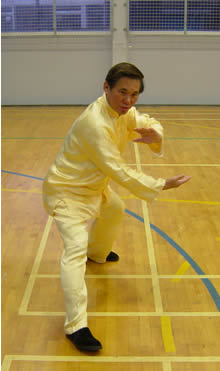
Sifu Wong channeling chi to his arms. This is an example of cultivating chi.
Question 8
(Editorial note: the e-mail below is purposely left unedited to show the style of the writer.)
Dear sifu wong,i am a beginner in the shaolin arts and do not understand why u ask for money. You and the shaolin temple “charge” for your knowledge, when it should just flow like water. Only those with the inner light or those devoted enough should be trained. I simply have just passed the gate and am now working on my stance training. I am not very far but i am devoted the art is more immensly deep then most people even know. Even you and my own sifu have tons of training beyond. I also believe you cant charge ppl a thousand dollars when they may get more knowledge in four days then they would in their whole life. But if there willing to pay and it pays for your desires then your green energy isnt so green anymore. For the true green dragon only shares his knowledge with the elite and does not publicize something that is supposed to be a secret.
— A newborn, country not stated
Answer
There are many reasons why I charge people who want to learn from me. For your information, it is sufficient to name just two of the reasons.
I am a professional, not an amateur, teacher. If you look around you will find the best professionals in their fields charge the highest fees.
From my own past experience, I have learnt that it is a waste of time teaching people like you, who do not want to pay their fees but think they themselves know a lot and have little or no respect for their teachers. What do you know, for example, about “green energy” or “the true green dragon”, yet you were giving advice as if you were an expert! My high fee acts as a deterrent against such people.
Your e-mail above shows the kind of attitude I would not want in my students. For example, you are not brave enough to use your real name, and you do not fulfill conditions specially stated as requirement for asking me questions, i.e. mentioning your country and the webpage from where you obtained the information.
You style of writing also shows that you place little importance on good manners, another requirement for becoming students of my school. Hence, even if you wanted to pay the fee, you would not be accepted to be my student or a student of my students.
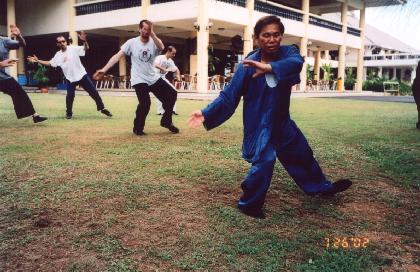
Sifu Wong leading a group of Taijiquan instructors to perform a Taijiquan set where energy flow instead of muscles is used to move physical forms
Question 9
I read through all your books on Chi Kung. Now I have some questions. Isn't Chi Kung practiced in a way like practicing ESP? I read a book about ESP, and in that book there was a section about obtaining energy from the “Cosmic Currents'” round us. We get an infinite supply of energy by breathing in deep through our nose and visualizing stale energy out our mouth. And to do this we have to be completely relaxed. This sounds VERY much like Chi Kung. Is all of this interconnected in some way?
— Stephen, USA
Answer
Yours are a good example of questions from people who read about chi kung or any art but never practice it. Some, but not you, basing on their reading or reasoning go to the ridiculous extent of telling the masters who have practiced the art and benefited from it, that the masters themselves were wrong, when the arm-chair critics never have any experience of the art at all!
Basing on what you have read, it is reasonable to think that chi kung is practiced in some ways like how ESP (extra sensory perception) is practiced. But if you have practiced chi kung, you would find practicing chi kung very different from practicing exercises to obtain ESP, although in some rare cases the two types of practices may be similar, and moreover practicing chi kung can lead to ESP.
An analogy will make the explanation clearer. Let us say you read something about playing tennis, as follows. To play tennis well we need energy. We get an infinite supply of energy by breathing in deeply through our nose and breathing out stale energy through our mouth. And to do this we have to be completely relaxed.
Someone who knows nothing about tennis and chi kung, but basing his reasoning from what he has read, may think that practicing chi kung is like playing tennis! Now, if he sees some chi kung exercises where the practitioner swings his arms like a tennis player does, and if some chi kung practitioners tell him that their chi kung training has improved their tennis performance, this person will further ascertain that practicing chi kung is like playing tennis. But of course we know that they are vastly different.
